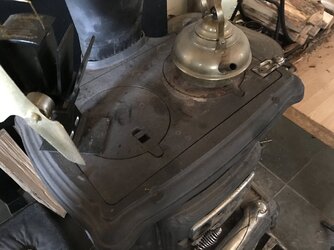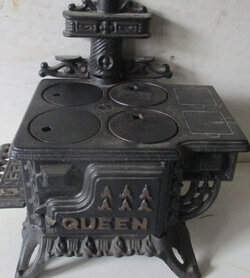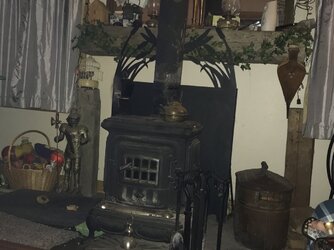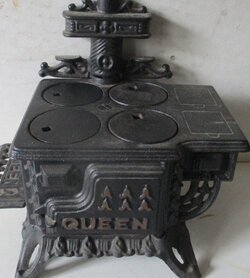burner covers
- Thread starter Hokypuk
- Start date
-
Active since 1995, Hearth.com is THE place on the internet for free information and advice about wood stoves, pellet stoves and other energy saving equipment.
We strive to provide opinions, articles, discussions and history related to Hearth Products and in a more general sense, energy issues.
We promote the EFFICIENT, RESPONSIBLE, CLEAN and SAFE use of all fuels, whether renewable or fossil.
You are using an out of date browser. It may not display this or other websites correctly.
You should upgrade or use an alternative browser.
You should upgrade or use an alternative browser.
How to use please 😊Cleaning, restoring, applying protective coating on working stoves or salesman samples?? Or how to use them?
I hope that isn't your install. But for using burner covers it depends upon what heat you want. If you want the most heat you pull the cover to get direct heat on the pan
Last edited:
A bit more information would be helpful….I hope that isn't your install. But for using burner covers it depends upon what heat you want. If you want the most heat you pull the cover to get direct heat on the pan
“I hope that isn’t your install”. I’m sorry, I don’t know what that means.About what?
Inadequate hearth protection. Inadequate clearances.“I hope that isn’t your install”. I’m sorry, I don’t know what that means.
Would you please be a little less vague?Inadequate hearth protection. Inadequate clearances.
Your hearth protection needs to extend 18" all the way around the stove. There needs to be 36" from the stove to any combustible materials in any direction.Would you please be a little less vague?
So, the dog beds are the problem? Please elaborate.Your hearth protection needs to extend 18" all the way around the stove. There needs to be 36" from the stove to any combustible materials in any direction.
Yes. What type of floor is the stove on?So, the dog beds are the problem? Please elaborate.
Ok in that case move combustibles away and make sure there is 36" in every direction to any combustible walls. What is under the slate?Cement and slate
Cement.. btw, I think the dogs are combustible, but they’re not moving… 😂🐶Ok in that case move combustibles away and make sure there is 36" in every direction to any combustible walls. What is under the slate?
As I said if you want more heat remove the covers and get direct flame on the pan. But is that actually a working stove? It looks like a salesman sample.So, does anyone please have the answer to my original question about those round removable things? Do I take it off, put a pan on it and hope it doesn’t smoke?
View attachment 294818
How far is it from the stove to the edge of the shield behind it? Is the shield spaced off the wall?
When the chimney is hot, the rising gases cause a low pressure area in chimney, pipe and open and stove. This allows the higher atmospheric air pressure to push into the stove intake feeding the fire oxygen. This is what makes the stove work. When you remove a lid, the higher air pressure pushes in, so smoke will not come out. If burning wood, the air leaking in makes the fire burn stronger.So, does anyone please have the answer to my original question about those round removable things? Do I take it off, put a pan on it and hope it doesn’t smoke?
View attachment 294818
Cooking on stove top, the highest heat is over firebox. You slide pots and pans to the area with the heat you want. If you want to cook faster, like searing meat, or boiling water, you remove a lid over the fire with a lifter tool. Set pan or kettle over hole for direct flame contact. You will learn to keep food moving, like wok cooking since it will get very hot quickly. It will cook just as fast as a gas stove top.
Some antique cast iron pans have a ring around the edge that seals to the stove top. This is called a smoke ring. You don’t need that type, but they seal better keeping the fire at the desired setting using the air intake.
Do you oil the top and lids? Has the stove been painted, or is it original stove black polished frequently? You treat the top differently than the rest of the stove.
Do you have a Queen stove, or is the one shown in pic what you are trying to use?? You are not picturing a working stove. We need to know what stove your question is in reference to, since many are operated differently.
Last edited:
This is the top. It has been repainted, but nothing else. What does oiling do and how do I do it? The other stove was just an example I pulled from the internet.When the chimney is hot, the rising gases cause a low pressure area in chimney, pipe and open and stove. This allows the higher atmospheric air pressure to push into the stove intake feeding the fire oxygen. This is what makes the stove work. When you remove a lid, the higher air pressure pushes in, so smoke will not come out. If burning wood, the air leaking in makes the fire burn stronger.
Cooking on stove top, the highest heat is over firebox. You slide pots and pans to the area with the heat you want. If you want to cook faster, like searing meat, or boiling water, you remove a lid over the fire with a lifter tool. Set pan or kettle over hole for direct flame contact. You will learn to keep food moving, like wok cooking since it will get very hot quickly. It will cook just as fast as a gas stove top.
Some antique cast iron pans have a ring around the edge that seals to the stove top. This is called a smoke ring. You don’t need that type, but they seal better keeping the fire at the desired setting using the air intake.
Do you oil the top and lids? Has the stove been painted, or is it original stove black polished frequently? You treat the top differently than the rest of the stove.
Do you have a Queen stove, or is the one shown in pic what you are trying to use?? You are not picturing a working stove. We need to know what stove your question is in reference to, since many are operated differently.

The Queen stove pic I pulled from the internet for illustration. The shield is away from the wall at the proper distance.As I said if you want more heat remove the covers and get direct flame on the pan. But is that actually a working stove? It looks like a salesman sample.
How far is it from the stove to the edge of the shield behind it? Is the shield spaced off the wall?
What distance is it? What distance is the stove from the wall when measured from the corner to the wall just past the shield?The Queen stove pic I pulled from the internet for illustration. The shield is away from the wall at the proper distance.
This is a parlor stove, not a cookstove. I'm not sure how well it will work with direct flame contact with the pan if the burner plate is removed. You will have to try it out and see. This is not like a wood cookstove where there are two operational modes, a straight path to the flue and diverted around the oven. If you can lift the burner lid and there is no smoke spillage then it may be ok to cook that way, but I suspect that the top can get hot enough that this won't be necessary for occasional cooking on it.
If the stove top had been painted, and you want to continue with a painted top, remove any rust with a wire wheel in drill, sandpaper or steel wool until cleaned down to bare cast iron where rusted. (The small area in pic can be cleaned with steel wool) Only be concerned about the outside. Paint with high temperature paint and fire when dry for final cure.This is the top. It has been repainted, but nothing else. What does oiling do and how do I do it? The other stove was just an example I pulled from the internet.
View attachment 294821
My response about oiling an antique range top is for an antique range that your picture was referring to. That picture is a salesman sample or toy stove, and not a working stove. That is what was confusing responses.
You do need to make sure the clearance to wall is sufficient behind your stove. The shield also does not look large enough.
If the wall is made of a combustible material, a approved heat shield (as described in NFPA 211) is required. The shield must be a non- combustible material monster on non-combustible spacers with 1 inch air space to wall. No wall fasteners within centerline of stove. It must have at least 1 inch opening at bottom for air to enter across bottom. It must be open across top for heated air to exit at top. The shield uses air rising behind it to cool the wall, not the material of the shield itself. This allows clearance reduction from 36 inches without shield down to a minimum of 12 inches to wall. (Measured time wall, not shield).
The size of the shield needs to be large enough that a 36 inch yard stick cannot touch stove and any part of wall or any other combustible material on any angle from any stove part measured to the combustible material.
The single wall stove pipe must be 18 inches from any combustible as well.
The shield is a foot from the wall and a foot from the stove.The Queen stove pic I pulled from the internet for illustration. The shield is away from the wall at the proper distance.
Similar threads
- Replies
- 6
- Views
- 527
- Replies
- 2
- Views
- 408
- Replies
- 4
- Views
- 448
- Replies
- 18
- Views
- 2K




